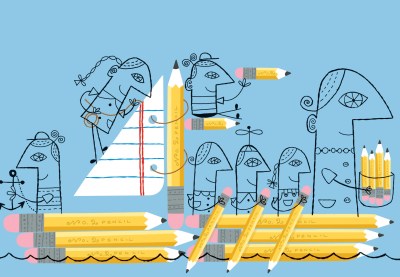Editor's note: This blog was originally published on May 12, 2014.
I recently taught a university course in Seattle for graduate students seeking master’s degrees in teaching. In one lesson, our focus was on creating a psychologically safe learning environment for students. It was an issue of managing students and supplies. I posed a question:
If a student shows up to class without a pencil, how should the teacher respond?
Small groups collaborated for a few minutes. Ultimately, they came up with plans involving taking something (a shoe?) from the student as collateral to remind the student about the importance of having supplies, notifying parents and even assigning classroom cleanup duty or lunch detention.
“What about you, Prof?” they asked.
“I would give the kid a pencil,” I said.
“You mean the first time?” someone asked.
“Every time,” I said.
This evidently had not occurred to them. There must be some punishment, subtle humiliation or a response that makes the kid pay for the error, right? They were concerned that my action would reinforce and reward poor behavior, possibly even help develop bad habits.
What they failed to see is that the teacher is not the cause of the problem. Likely, the student has been doing this for years. The teacher can respond by criticizing the child in front of the class, reminding him that pencils are required at school, making her give up something as collateral or inflicting some punishment as a power move.
Or the instructor can simply provide the pencil and say, “There will always be a pencil here for you. Don’t ever worry about asking me for a pencil. I have hundreds of them.”
By eliminating the anxiety that comes when students worry about being called out or humiliated in front of their peers, teachers reduce the chance that students will skip class, give up, become defiant or develop mysterious “illnesses” that cause them to stay home.
Obviously, these students struggle with remembering supplies. This is likely the result of many factors in their lives, none of which has anything to do with the teacher. Perhaps it is ADHD or a medication side effect, stress or simple forgetfulness or immaturity. (They are, after all, just kids, right?) What good does it do to rub it in their faces every day? And years later, what are they likely to remember about the class or the teacher?
“But what about the student who takes advantage of you?” one of the graduate students asked. “How do you know they aren’t doing it on purpose?”
Of course there is the chance I will be taken advantage of. I welcome this chance. I resolve to remain a patient advocate for the child even if he is testing me. When I hand him the 50th pencil and remind him there is always one here, what will be his likely impression? Has humiliation worked so far in his educational experience? Has the status quo resolved the issue? Imagine the impact of endless advocacy. We should all be extended such grace.
Also, students who are constantly badgered for forgetting pencils start stealing pencils to avoid being singled out and embarrassed. One could argue that shaming leads to the stealing. A child will go to great lengths to avoid humiliation.
“How do you get all those pencils?” my students asked.
I am a college graduate and a professional. I have no trouble accessing the power structure of our community. How can I complain about finding pencils? In light of what so many others struggle with daily, this problem is minor. Find a way. Pay for them, borrow them, ask companies to donate them, hit up family members for pencils as holiday gifts. Have a pencil drive. Do a car wash for pencils. I don’t know, but figure it out. Life is a cycle of problem solving. You can find the pencils.
Students learn best in a psychologically safe, mistake-friendly environment. We all make mistakes. How teachers respond has everything to do with whether or not their students feel valued as human beings. We are responsible for creating a psychologically safe classroom. In all possible situations, we should seek to uphold the dignity of the student. Even when disciplinary action is necessary, it should be handled in a dignified way.
“Mr. D, can I have a pencil?"
“Of course, anytime."
Donohue is a middle school English and social studies teacher in Monroe, Washington. He also teaches college courses in English, public speaking and education.


3 COMMENTS